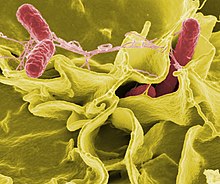Salmonella
| Salmonella | |
|---|---|
 |
|
| Scientific classification | |
| Domain: | Bacteria |
| Kingdom: | Eubacteria |
| Phylum: | Proteobacteria |
| Class: | Gammaproteobacteria |
| Order: | Enterobacteriales |
| Family: | Enterobacteriaceae |
| Genus: |
Salmonella Lignieres 1900 |
| Species | |
Salmonella /ˌsælməˈnɛlə/ is a genus of rod-shaped (bacillus) gram-negative bacteria of the Enterobacteriaceae family. The two species of Salmonella are Salmonella enterica and Salmonella bongori. Salmonella enterica is the type species and is further divided into six subspecies that include over 2500 serotypes.
S. enterica subspecies are found worldwide in all warm-blooded animals, and in the environment. S. bongori is restricted to cold-blooded animals, particularly reptiles. Strains of Salmonella cause illnesses such as typhoid fever, paratyphoid fever, and food poisoning (salmonellosis).
Salmonella species are nonspore-forming, predominantly motile enterobacteria with cell diameters between about 0.7 and 1.5 µm, lengths from 2 to 5 µm, and peritrichous flagella (all around the cell body). They are chemotrophs, obtaining their energy from oxidation and reduction reactions using organic sources. They are also facultative anaerobes, capable of surviving with or without oxygen.
...
Wikipedia
